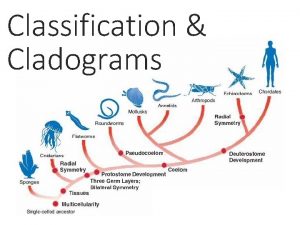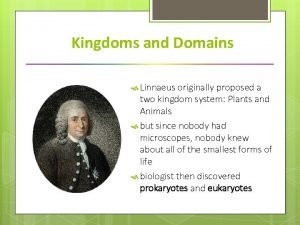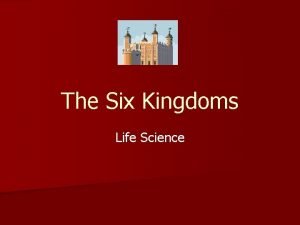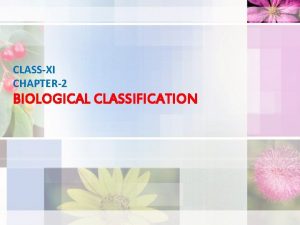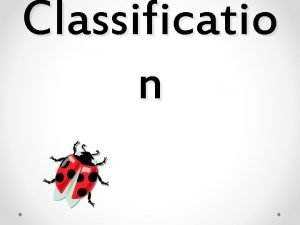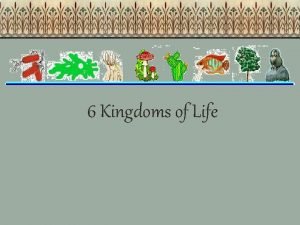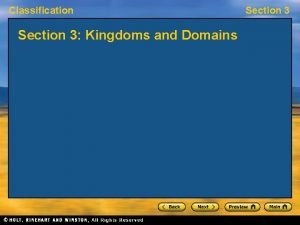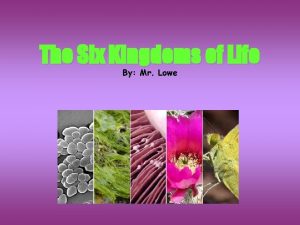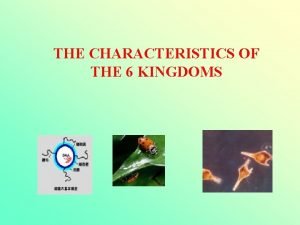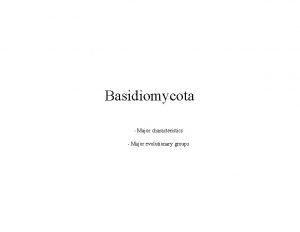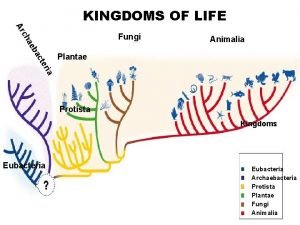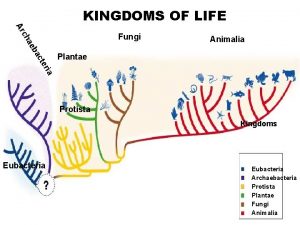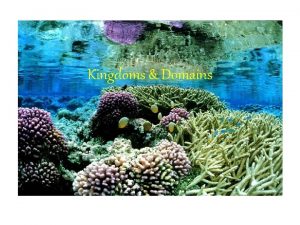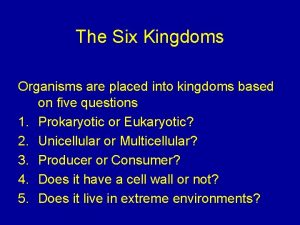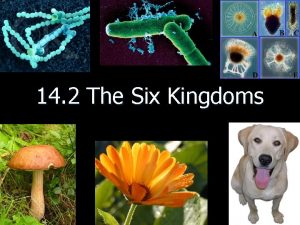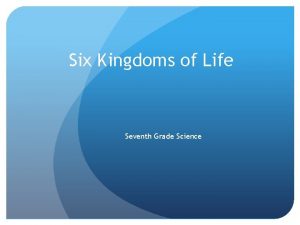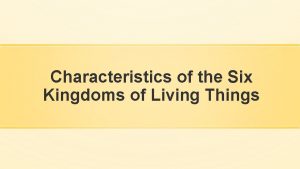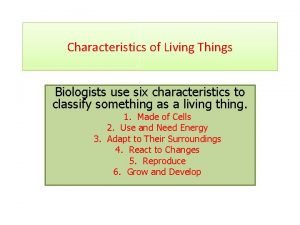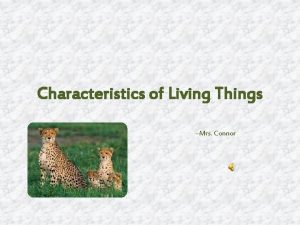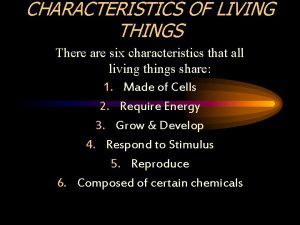Major Characteristics of the Six Kingdoms Six Kingdoms






































- Slides: 38

Major Characteristics of the Six Kingdoms

Six Kingdoms • Archaebacteria • Eubacteria • Protista • Fungi • Plantae • Animalia

Archaebacteria Cell Type: • Prokaryotes – no bound organelles, “pro” means first

Eubacteria Cell Type: • Prokaryotes

Protista Cell Type: • Eukaryotes

Fungi Cell Type: • Eukaryotes

Plantae Cell Type: • Eukaryotes

Animalia Cell Type: • Eukaryotes

Archaebacteria Cell Structures: • No nucleus, no membrane bound structures • Cell membrane contains lipid not found in other organisms

Eubacteria Cell Structure: • No nucleus • Have cells walls made up of peptidoglycan

Protista Cell Structures: • Cell membrane • Well defined nucleus • Membrane bound organelles

Fungi Cell Structures: • Have a nucleus and mitochondria • No chloroplasts • Cell wall of chitin

Plantae Cell Structures: • Nucleus • Cell membrane • Cell wall • Chloroplasts

Animalia Cell Structures: • Nucleus • Cell membrane • No cell wall • No chloroplasts

Archaebacteria Body Form: • Unicellular

Eubacteria Body Form: • Unicellular • Colonies (groups)

Protista Body Form: • Mostly unicellular • Some multicellular (colonies)

Fungi Body Form: • Unicellular • Multicellular

Plantae Body Form: • Multicellular

Animalia Body Forms: • Multicellular

Archaebacteria Nutrition: • Autotrophic – Chemosynthetic

Eubacteria Nutrition: • Autotrophic • Heterotrophic

Protista Nutrition: • Autotrophic • Heterotrophic –Symbiotic (living together and one is benefiting)

Fungi Nutrition: • Heterotrophic – Decomposers – Symbiotic

Plantae Nutrition: • Autotrophic – Photosynthetic

Animalia Nutrition: • Heterotrophic

Archaebacteria Special Adaptations: • Methanogens • Halophiles • Thermophiles • Chemosynthetic

Eubacteria Special Adaptations: • Nitrogen fixing • Found in most habitats • Aerobic or anaerobic types • Conjugation

Protista Special Adaptations: • Fungi-like molds and mildews • Plant-like algae with alternation of generations (spores vs. gametes) • Animal-like protozoans, some with pseudopodia, conjugation, cysts, or spores

Fungi Special Adaptations: • Most reproduce with spores (sexually or asexually) • Extracellular digestion • Feeding relationships

Plantae Special Adaptations: • In most habitats • Sexual reproduction (spores or seeds) • Alternation of generations • Photosynthetic • Roots/stems/leaves/ cuticle

Animalia Special Adaptations: • Find or capture food • Fat for food storage • Specialized cells • Adapted to environment

Archaebacteria Examples: • Methanogens • Halophiles • Thermophiles

Eubacteria Examples: • Rhizobium • E. coli • Salmonella

Protista Examples: • Euglena • Amoeba • Volvox • Paramecium • Diatoms

Fungi Examples: • Yeasts • Molds • Mushrooms • Lichens • Penicillium

Plantae Examples: • Mosses • Ferns • Flowering plants • Seaweeds • Trees

Animalia Examples: • Gemsbok • Dogs • Cats • Humans
 Cladogram review
Cladogram review Common characteristics of the six kingdoms of life
Common characteristics of the six kingdoms of life Characteristics of the six kingdoms
Characteristics of the six kingdoms 6 kingdoms dichotomous key
6 kingdoms dichotomous key Are archaebacteria autotrophs
Are archaebacteria autotrophs Holozoid
Holozoid How do scientists classify protists
How do scientists classify protists Examples of the 6 kingdoms
Examples of the 6 kingdoms What are the kingdoms of living things
What are the kingdoms of living things What are the three domains and six kingdoms?
What are the three domains and six kingdoms? What are the six kingdoms of life?
What are the six kingdoms of life? Characteristics of the 6 kingdoms
Characteristics of the 6 kingdoms Plantae kingdom characteristics chart
Plantae kingdom characteristics chart Six major religions
Six major religions Types of utility software
Types of utility software Hát kết hợp bộ gõ cơ thể
Hát kết hợp bộ gõ cơ thể Ng-html
Ng-html Bổ thể
Bổ thể Tỉ lệ cơ thể trẻ em
Tỉ lệ cơ thể trẻ em Voi kéo gỗ như thế nào
Voi kéo gỗ như thế nào Glasgow thang điểm
Glasgow thang điểm Bài hát chúa yêu trần thế alleluia
Bài hát chúa yêu trần thế alleluia Kể tên các môn thể thao
Kể tên các môn thể thao Thế nào là hệ số cao nhất
Thế nào là hệ số cao nhất Các châu lục và đại dương trên thế giới
Các châu lục và đại dương trên thế giới Công thức tiính động năng
Công thức tiính động năng Trời xanh đây là của chúng ta thể thơ
Trời xanh đây là của chúng ta thể thơ Mật thư anh em như thể tay chân
Mật thư anh em như thể tay chân 101012 bằng
101012 bằng độ dài liên kết
độ dài liên kết Các châu lục và đại dương trên thế giới
Các châu lục và đại dương trên thế giới Thể thơ truyền thống
Thể thơ truyền thống Quá trình desamine hóa có thể tạo ra
Quá trình desamine hóa có thể tạo ra Một số thể thơ truyền thống
Một số thể thơ truyền thống Bàn tay mà dây bẩn
Bàn tay mà dây bẩn Vẽ hình chiếu vuông góc của vật thể sau
Vẽ hình chiếu vuông góc của vật thể sau Nguyên nhân của sự mỏi cơ sinh 8
Nguyên nhân của sự mỏi cơ sinh 8 đặc điểm cơ thể của người tối cổ
đặc điểm cơ thể của người tối cổ Thế nào là giọng cùng tên?
Thế nào là giọng cùng tên?
